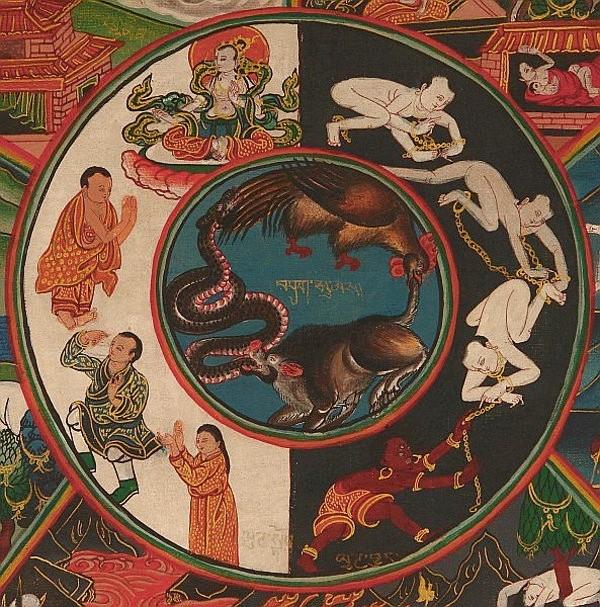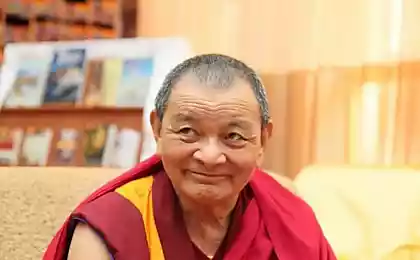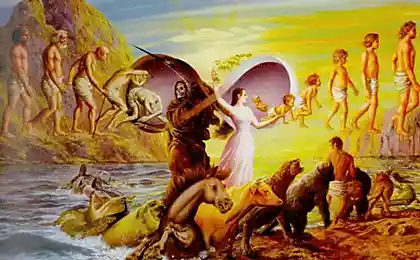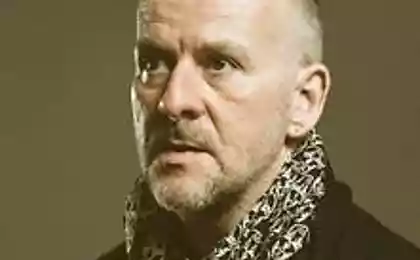628
The belief in the transmigration of souls — a pseudoscientific delusion
Reincarnation, metempsychosis or the transmigration of souls is a collection of religious and philosophical doctrines that say about the immortal essence of a living being that is reincarnated from one body to another. This immortal entity is called by different names: soul, spirit, divine spark, the true "I". According to some religions and doctrines of the chain of reincarnation has a specific purpose, and the soul in process of reincarnation develops.
It should be noted that the concept of reincarnation is not inherent to religious systems, but also personal Outlook of a person.

In General, the belief in reincarnation is an ancient phenomenon, it exists in many Nations. For example, among certain peoples (Jews, Indians, Eskimos) it is considered that at birth it possesses the soul of someone from the dead relatives. In many Indian religions the doctrine of the transmigration of souls occupies a Central place. The speech in this case goes about Hinduism as such its manifestations as Vaishnavism, shaivism and yoga, but also in Sikhism and Jainism.
The idea of reincarnation was accepted and some of the ancient philosophers, particularly Plato, Pythagoras and Socrates. The belief in the transmigration of souls inherent in some modern traditions, in particular, followers of spiritism, the new age movement, and supporters of the Kabbalah, Gnosticism, and esoteric Christianity.
If we talk about the belief in reincarnation in General, it should be noted that it is based on several components. First, the idea that everyone has some entity (soul, spirit), where lies the identity, its identity, part of what people used to call "Me". This entity can have a relationship with the physical body, but this relation is not indissoluble. Therefore, the soul continues to exist even after physical death of the body. The question of the existence of the soul in other living creatures, besides man, in the various religions is solved in different ways. Second, the idea that after physical death the soul is incarnated in another body, that is, the life of the personality is possible outside the physical body.
In the Eastern religions and traditions, in the same way as in Buddhism and Hinduism, there is the theory of the continuity of life, that is, the soul after death from one body moves to another. Supporters of the Eastern beliefs do not have alternatives to the concept of "reincarnation". They believe that it exists as logical and fair, because it turns out that a godly moral behavior that enables a person to progress with each new life, each time getting improved circumstances and conditions of life. And even more than that, reincarnation as if is the testimony of God's compassion for all creatures, since each new incarnation the soul is given one chance to correct mistakes and improve. Progressing thus, the soul from one life to another can be purified so that they can attain liberation.
Religious and Eastern philosophical beliefs regarding the existence of the soul had a direct bearing on how reincarnation is considered in various Eastern teachings, between which there are significant differences. So, some completely deny the existence of "I", others say that there is eternal personal essence of the individual, while others argue that the existence of "I" and its non-existence is just an illusion. All these teachings have a great influence on the definition of the concept of the transmigration of souls.
In Hinduism reincarnation is one of the basic concepts. In this religion the cycle of life and death is accepted as natural phenomenon. On the transmigration of souls is first mentioned in the Vedas, the most ancient Hindu Scriptures. Despite the fact that most scientists believe that the doctrine of reincarnation is not recorded in the "rig Veda", some scientists still suggest that some elements of the theory of reincarnation represented there.
The most detailed description of reincarnation is served in the Upanishads – ancient philosophical and religious texts written in Sanskrit, which are closely adjacent to the Vedas. In particular, it says that just as the human body grows at the expense of food and exercise, and the spiritual "I" feeds your desires, aspirations, visual impressions, sensitive connections and misconceptions acquires the desired shape.
The soul of Hinduism is immortal, birth and death only affects the body. And the idea of the transmigration of souls has a close relationship with the concept of karma. After repeated birth and death the soul gives up earthly pleasures, and trying to find a higher pleasure, which can be achieved only with the acquisition of spiritual experience. When all material desires end, and the soul is no longer reborn, they say that the individual has achieved salvation.
In Buddhism the scheme of formation of rebirths is contained in the formula of existence. Despite the fact that in Buddhist folklore and literature we can find many arguments and stories the transmigration of souls, the Buddhist denies the existence of the soul, so reincarnation does not recognize. At the same time, in Buddhism there is the concept of Santana or extent of consciousness, which has no constant support. Consciousness wanders the realms (there are six), as well as the worlds of the sphere of forms and neform divided into a residence. All these walks can occur both during life and after death, and being in a different world defined mental state. And the seat is determined by the previous actions or karma.
For Chinese Buddhism is characterized by a slightly different representation of the transmigration of souls. Chinese Buddhism is called mundane, so he often neglects such concepts as reincarnation and other abstractions at the same time, attaching great importance to the beauty of nature. This is due to the influence of the teachings of Chinese teachers, in particular, Confucius and Lao Tzu, which attached great importance to the beauty of the natural world.
Shinto recognizes the possibility of the transmigration of souls. It is generally accepted that the soul which was reborn in a new body does not store memories of previous lives, but at the same time, can show the talents and skills acquired and developed in past incarnations.
In Christianity, in all its manifestations, the possibility of reincarnation is denied. At the same time, there is an alternative view of the history of reincarnation in Christianity, which became widespread in the late 19th — early 20th century among the Theosophists. Later, this alternative perspective was adopted by the adherents of the new age movement who claim that reincarnation was accepted by early Christianity, but was later rejected.
Now re-attempts to relate reincarnation with Christianity. An example is the numerous books, in particular, the work of D. Geddes MacGregor "Reincarnation in Christianity: a new vision of rebirth in Christian thought". In addition, the theory of reincarnation adopted by the next marginal Christian organizations and sects belong to the "Liberal Catholic Church", "Christian society", "Church unity" that professed Gnostic, Theosophical and mystical ideas.
As for Muslims, they have a rather complicated system of ideas about the nature of death, about the moment of dying, but also about what happens after death. According to Islamic belief, the soul after death is placed behind a certain barrier, and the body buried in the ground, gradually decomposes and turns to dust. And only on judgment day will be established a new body, which will flock of the soul. After this resurrection the people stand before the Almighty and will be responsible for all their deeds.
In modern life the number of people who believe in reincarnation has increased considerably. Interest in reincarnation is characteristic of the representatives of American transcendentalism, theosophy. In these exercises the human soul is regarded as pure and has great potential. And reincarnation, in turn, acts as a process through which the soul gradually reveals its potential in the formal world.
The theory of the transmigration of souls plays an important role in anthroposophy – an esoteric spiritual movement founded by Rudolf Steiner. He described the human soul as an entity, acquiring experience in the process of reincarnations. In anthroposophy it is said that the present is a result of the confrontation between the past and the future. The real destiny of man is affected and the future and the past. Between them there is such a thing as freedom of will: man creates their own destiny and not just live it.
If we talk about reincarnation from a scientific point of view, her research studied the American psychiatrist Ian Stevenson, who conducted a study on the occurrence of memories of people's past lives, providing them the real facts and descriptions of events that have been associated with a hypothetical past life. Stevenson was described more than two thousand cases. As says the author in his study were only those cases that could be documented to verify. He also noted that in most of these cases documentary evidence of past life was found. In particular, it was confirmed the names of relatives, description of place of residence.
There is a critical analysis of the research of Stevenson. In particular, we are talking about the history of Edward Rael, who claimed that he lived in the 17th century in the English County under the name of John Fletcher. But check on the parish books showed that no one by that name existed.
In addition, there are a lot of descriptions of cases of so-called false memories that were triggered by the previously obtained information stored in the subconscious. Besides, most scholars tend to argue that no science-based evidence for the existence of the phenomenon of reincarnation does not exist.
Therefore, belief in the existence of the transmigration of souls is one of the most common pseudoscientific delusions.
Source: globalscience.ru
It should be noted that the concept of reincarnation is not inherent to religious systems, but also personal Outlook of a person.

In General, the belief in reincarnation is an ancient phenomenon, it exists in many Nations. For example, among certain peoples (Jews, Indians, Eskimos) it is considered that at birth it possesses the soul of someone from the dead relatives. In many Indian religions the doctrine of the transmigration of souls occupies a Central place. The speech in this case goes about Hinduism as such its manifestations as Vaishnavism, shaivism and yoga, but also in Sikhism and Jainism.
The idea of reincarnation was accepted and some of the ancient philosophers, particularly Plato, Pythagoras and Socrates. The belief in the transmigration of souls inherent in some modern traditions, in particular, followers of spiritism, the new age movement, and supporters of the Kabbalah, Gnosticism, and esoteric Christianity.
If we talk about the belief in reincarnation in General, it should be noted that it is based on several components. First, the idea that everyone has some entity (soul, spirit), where lies the identity, its identity, part of what people used to call "Me". This entity can have a relationship with the physical body, but this relation is not indissoluble. Therefore, the soul continues to exist even after physical death of the body. The question of the existence of the soul in other living creatures, besides man, in the various religions is solved in different ways. Second, the idea that after physical death the soul is incarnated in another body, that is, the life of the personality is possible outside the physical body.
In the Eastern religions and traditions, in the same way as in Buddhism and Hinduism, there is the theory of the continuity of life, that is, the soul after death from one body moves to another. Supporters of the Eastern beliefs do not have alternatives to the concept of "reincarnation". They believe that it exists as logical and fair, because it turns out that a godly moral behavior that enables a person to progress with each new life, each time getting improved circumstances and conditions of life. And even more than that, reincarnation as if is the testimony of God's compassion for all creatures, since each new incarnation the soul is given one chance to correct mistakes and improve. Progressing thus, the soul from one life to another can be purified so that they can attain liberation.
Religious and Eastern philosophical beliefs regarding the existence of the soul had a direct bearing on how reincarnation is considered in various Eastern teachings, between which there are significant differences. So, some completely deny the existence of "I", others say that there is eternal personal essence of the individual, while others argue that the existence of "I" and its non-existence is just an illusion. All these teachings have a great influence on the definition of the concept of the transmigration of souls.
In Hinduism reincarnation is one of the basic concepts. In this religion the cycle of life and death is accepted as natural phenomenon. On the transmigration of souls is first mentioned in the Vedas, the most ancient Hindu Scriptures. Despite the fact that most scientists believe that the doctrine of reincarnation is not recorded in the "rig Veda", some scientists still suggest that some elements of the theory of reincarnation represented there.
The most detailed description of reincarnation is served in the Upanishads – ancient philosophical and religious texts written in Sanskrit, which are closely adjacent to the Vedas. In particular, it says that just as the human body grows at the expense of food and exercise, and the spiritual "I" feeds your desires, aspirations, visual impressions, sensitive connections and misconceptions acquires the desired shape.
The soul of Hinduism is immortal, birth and death only affects the body. And the idea of the transmigration of souls has a close relationship with the concept of karma. After repeated birth and death the soul gives up earthly pleasures, and trying to find a higher pleasure, which can be achieved only with the acquisition of spiritual experience. When all material desires end, and the soul is no longer reborn, they say that the individual has achieved salvation.
In Buddhism the scheme of formation of rebirths is contained in the formula of existence. Despite the fact that in Buddhist folklore and literature we can find many arguments and stories the transmigration of souls, the Buddhist denies the existence of the soul, so reincarnation does not recognize. At the same time, in Buddhism there is the concept of Santana or extent of consciousness, which has no constant support. Consciousness wanders the realms (there are six), as well as the worlds of the sphere of forms and neform divided into a residence. All these walks can occur both during life and after death, and being in a different world defined mental state. And the seat is determined by the previous actions or karma.
For Chinese Buddhism is characterized by a slightly different representation of the transmigration of souls. Chinese Buddhism is called mundane, so he often neglects such concepts as reincarnation and other abstractions at the same time, attaching great importance to the beauty of nature. This is due to the influence of the teachings of Chinese teachers, in particular, Confucius and Lao Tzu, which attached great importance to the beauty of the natural world.
Shinto recognizes the possibility of the transmigration of souls. It is generally accepted that the soul which was reborn in a new body does not store memories of previous lives, but at the same time, can show the talents and skills acquired and developed in past incarnations.
In Christianity, in all its manifestations, the possibility of reincarnation is denied. At the same time, there is an alternative view of the history of reincarnation in Christianity, which became widespread in the late 19th — early 20th century among the Theosophists. Later, this alternative perspective was adopted by the adherents of the new age movement who claim that reincarnation was accepted by early Christianity, but was later rejected.
Now re-attempts to relate reincarnation with Christianity. An example is the numerous books, in particular, the work of D. Geddes MacGregor "Reincarnation in Christianity: a new vision of rebirth in Christian thought". In addition, the theory of reincarnation adopted by the next marginal Christian organizations and sects belong to the "Liberal Catholic Church", "Christian society", "Church unity" that professed Gnostic, Theosophical and mystical ideas.
As for Muslims, they have a rather complicated system of ideas about the nature of death, about the moment of dying, but also about what happens after death. According to Islamic belief, the soul after death is placed behind a certain barrier, and the body buried in the ground, gradually decomposes and turns to dust. And only on judgment day will be established a new body, which will flock of the soul. After this resurrection the people stand before the Almighty and will be responsible for all their deeds.
In modern life the number of people who believe in reincarnation has increased considerably. Interest in reincarnation is characteristic of the representatives of American transcendentalism, theosophy. In these exercises the human soul is regarded as pure and has great potential. And reincarnation, in turn, acts as a process through which the soul gradually reveals its potential in the formal world.
The theory of the transmigration of souls plays an important role in anthroposophy – an esoteric spiritual movement founded by Rudolf Steiner. He described the human soul as an entity, acquiring experience in the process of reincarnations. In anthroposophy it is said that the present is a result of the confrontation between the past and the future. The real destiny of man is affected and the future and the past. Between them there is such a thing as freedom of will: man creates their own destiny and not just live it.
If we talk about reincarnation from a scientific point of view, her research studied the American psychiatrist Ian Stevenson, who conducted a study on the occurrence of memories of people's past lives, providing them the real facts and descriptions of events that have been associated with a hypothetical past life. Stevenson was described more than two thousand cases. As says the author in his study were only those cases that could be documented to verify. He also noted that in most of these cases documentary evidence of past life was found. In particular, it was confirmed the names of relatives, description of place of residence.
There is a critical analysis of the research of Stevenson. In particular, we are talking about the history of Edward Rael, who claimed that he lived in the 17th century in the English County under the name of John Fletcher. But check on the parish books showed that no one by that name existed.
In addition, there are a lot of descriptions of cases of so-called false memories that were triggered by the previously obtained information stored in the subconscious. Besides, most scholars tend to argue that no science-based evidence for the existence of the phenomenon of reincarnation does not exist.
Therefore, belief in the existence of the transmigration of souls is one of the most common pseudoscientific delusions.
Source: globalscience.ru























